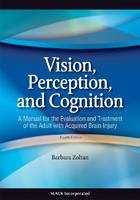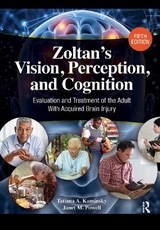
Vision, Perception, and Cognition
SLACK Incorporated (Verlag)
978-1-55642-738-1 (ISBN)
- Titel erscheint in neuer Auflage
- Artikel merken
Vision Perception and Cognition, Fourth Edition is a concisely structured text that expertly addresses clinical reasoning and decision making for the entire evaluation and treatment process of the adult with acquired brain injury. Provided are theoretical information, guidelines for both static and dynamic assessment, information on specific standardized evaluations, guidelines for adaptive and restorative treatment based on described theoretical and evidence-based information, and information on environmental impact of client performance.
Inside this best-selling book, Barbara Zoltan, MA, OTR/L addresses visual, perceptual, and cognitive evaluation and treatment, providing structure, clarity, and content suitable for both students and experienced clinicians.
Updated and expanded to reflect current practice and relevant research, Vision, Perception, and Cognition, Fourth Edition is a unique resource that takes the reader from theory to practice in a practical and detailed way.
Students and clinicians will benefit from the numerous tables, figures, and extensive references presented throughout the text, as well as the inclusion of a glossary, for easy reference to terminology used throughout Vision, Perception, and Cognition, Fourth Edition. Faculty will be impressed by the addition of an on-line instructor’s manual for additional classroom learning objectives and activities.
Component areas covered include:
• Primary visual skills
• Apraxia and agnosia
• Visual discrimination skills
• Orientation
• Attention
• Memory
• Self-awareness and monitoring
• Planning and organization
• Problem solving and decision making
• Categorization
• Mental flexibility
• Abstraction
• Generalization and transfer
• Acalculia
New topics addressed in this Fourth Edition:
• Constraint-induced therapy
• Brain plasticity/Functional reorganization
• Neuroimaging
• Specific occupation-based models and evaluations
• Contextual influence on client performance
• Client-centered practice
• Client learning capacity
• Clinical reasoning
• Interviewing
• Standardization
• Visual vestibular processing
• Pupillary response
• Contrast sensitivity
Whether you are a student or clinician in the area of occupational therapy, physical therapy, neuropsychology, optometry, or speech pathology, Vision, Perception, and Cognition: A Manual for the Evaluation and Treatment of the Adult with Acquired Brain Injury, Fourth Edition will continue to be an invaluable resource for exploring theory and practice in the evaluation and treatment processes.
Barbara Zoltan, MA, OTR/L is a consultant in Southern California. She obtained her bachelor's degree in Occupational Therapy from Tufts University and her master's degree from the University of Southern California. She holds certifications in both sensory integration and neurodevelopmental treatment and has served on the editorial boards of the Journal of Head Trauma Rehabilitation and Occupational Therapy in Health Care. Her more than 20 years of experience specializing in neurological rehabilitation has included a broad range of research, teaching, administrative and clinical practice. She has published over 20 articles, chapters, and books related to the adult with acquired brain injury.
Contents
Dedication
Acknowledgments
About the Author
Foreword
Preface
Chapter 1: Theoretical and Additional Factors Guiding Evaluation and Treatment
Section I: Theoretical Basis
Theory as a Basis for Evaluation and Treatment
Frames of Reference Utilizing a Restorative Conceptual Base: Bottom-Up Approaches
Frames of Reference Utilizing an Adaptive Conceptual Base: Top-Down Approaches
Section II: Additional Factors Guiding Evaluation and Treatment
Client-Centered Practice
Client and Family Education
The Client's Learning Capacity and Its Influence on Performance
Evidence-Based Practice
Clinical Reasoning
Chapter 2: General Evaluation Issues
Top-Down and Bottom-Up Assessments
Occupation-Based Evaluations
Quantitative (Static) Assessment
Qualitative Assessment
Clinical Observation
Interviewing
Dynamic Assessment
Test Reliability
Test Validity
Standardization
Test Scoring
Administration of Tests
Evaluation Choice
Chapter 3: Visual Processing Skills
Modified Information Processing Theory
Warren's Hierarchal Model of Visual Processing
Evaluation and Treatment of Visual Skills
General Guidelines for Visual Processing Skills Evaluation
Pupillary Response
Visual Acuity
Contrast Sensitivity
Ocular Alignment
Visual Fields
Oculomotor Control
Visual Fixation
Saccadic Eye Movements
Smooth Pursuit Eye Movements
Organized Scanning
Convergence and Accommodation
Diplopia
Visual Inattention
Visual/Vestibular Processing
Chapter 4: Apraxia
Ideomotor Apraxia
Ideational Apraxia
Limb-Kinetic Apraxia
Oral Apraxia
Constructional Apraxia
Dressing Apraxia
Chapter 5: Body Scheme Disorders
Body Scheme
Autotopagnosia
Unilateral Body Neglect
Anosognosia
Right-Left Discrimination
Finger Agnosia
Chapter 6: Visual Discrimination Skills
Form Discrimination
Depth Perception (Stereopsis)
Figure-Ground Perception
Spatial Relations
Topographical Disorientation
Additional Test Batteries of Visual Discrimination/Perception
Chapter 7: Agnosia
Visual Agnosia
Visual Object Agnosia
Prosopagnosia
Simultagnosia
Color Agnosia
Metamorphopsia
Visual-Spatial Agnosia
Topographagnosia
Environmental Agnosia
Tactile Agnosia
Auditory Agnosia
Apractognosia
Agnosias Related to Body-Scheme Disorders
Chapter 8: Orientation and Attention
Orientation
Attention
Chapter 9: Memory
Sensory, Perceptual, and Working Memory
Implicit and Explicit Memory
Declarative and Nondeclarative (Procedural) Memory
Prospective Memory
Semantic and Episodic Memory
Long-Term Memory
Chapter 10: Executive Function
Executive Function
Section I: Evaluation and Treatment of Self-Awareness and Monitoring
Section II: Evaluation and Treatment of Executive Function
Initiation
Planning and Organization
Problem Solving
Decision Making
Categorization
Mental Flexibility
Abstraction
Generalization and Transfer
Section III: Occupation-Based Evaluations of Executive Function
Chapter 11: Acalculia
Acalculia
Chapter 12: Factors That Influence the Client's Vision, Perception, and Cognition
The Relationship of Age to Visual, Perceptual, and Cognitive Evaluation and Treatment
Sleep Disorders
Motivation
Depression
Behavior and Personality Changes
Additional Factors Affecting Performance
Chapter 13: The Use of Computers and Computerized Technology in Visual Perceptual, and Cognitive Retraining
Computers
Computerized Technology
Appendix A: Common Statistical Terms and Analyses Used in Clinical Research Studies
Appendix B: Evaluation Index
Appendix C: Glossary of Terms
Index
| Erscheint lt. Verlag | 30.5.2007 |
|---|---|
| Sprache | englisch |
| Maße | 178 x 254 mm |
| Gewicht | 887 g |
| Themenwelt | Geisteswissenschaften ► Psychologie ► Allgemeine Psychologie |
| Geisteswissenschaften ► Psychologie ► Verhaltenstherapie | |
| Medizin / Pharmazie ► Medizinische Fachgebiete ► Neurologie | |
| ISBN-10 | 1-55642-738-7 / 1556427387 |
| ISBN-13 | 978-1-55642-738-1 / 9781556427381 |
| Zustand | Neuware |
| Haben Sie eine Frage zum Produkt? |
aus dem Bereich



